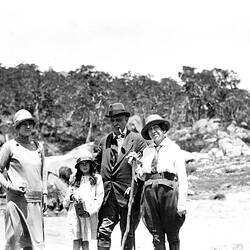Summary
Two men digging potatoes on farm built under the Closer Settlement Act, Yannathan, West Gippsland, 1930.
Description of Content
Two men digging potatoes on farm built under the Closer Settlement Act.
Significance
Following the 1890s depression, concern arose that too many people were living in Melbourne, especially in the crowded inner suburbs. Large cities were likened to cancers, spreading disease and sapping the nation's strength. The Victorian Government's Closer Settlement Scheme was established in 1904 to entice people away from the inner city. Small holdings for farming were made available throughout the state. In Melbourne, land was subdivided for workers' homes in the fringe suburbs of Footscray, Brunswick, Northcote and Thornbury, and for 'clerks' in the eastern suburbs of Glenhuntly and Tooronga.
In 1915, a royal commission found that the scheme was seriously flawed. Water, sewerage, roads, schools and other infrastructure lagged behind the construction of homes, and the blocks of land were often too small to be viable as farms. By 1916, about 1000 homes had been built. Residents struggled for years, however, to get such basic amenities as roads and water supply. -Melbourne Story text panel, 2008
More Information
-
Collection Names
-
Collecting Areas
-
Acquisition Information
Copied from Mrs Wynne E Jennings, 22 Aug 1991
-
Place & Date Depicted
-
Individuals Identified
Owen, George; Owen Family
-
Format
Negative, 35 mm, Black & White
-
Classification
Agriculture & rural life, Crop management - harvesting, Workers
-
Category
-
Discipline
-
Type of item
-
Keywords
Agricultural Workers, Closer Settlement Schemes, Farms, Vegetables
![[Digging potatoes on a closer settlement farm, Yannathan, West Gippsland, 1930.]](/content/media/13/160963-small.jpg)
